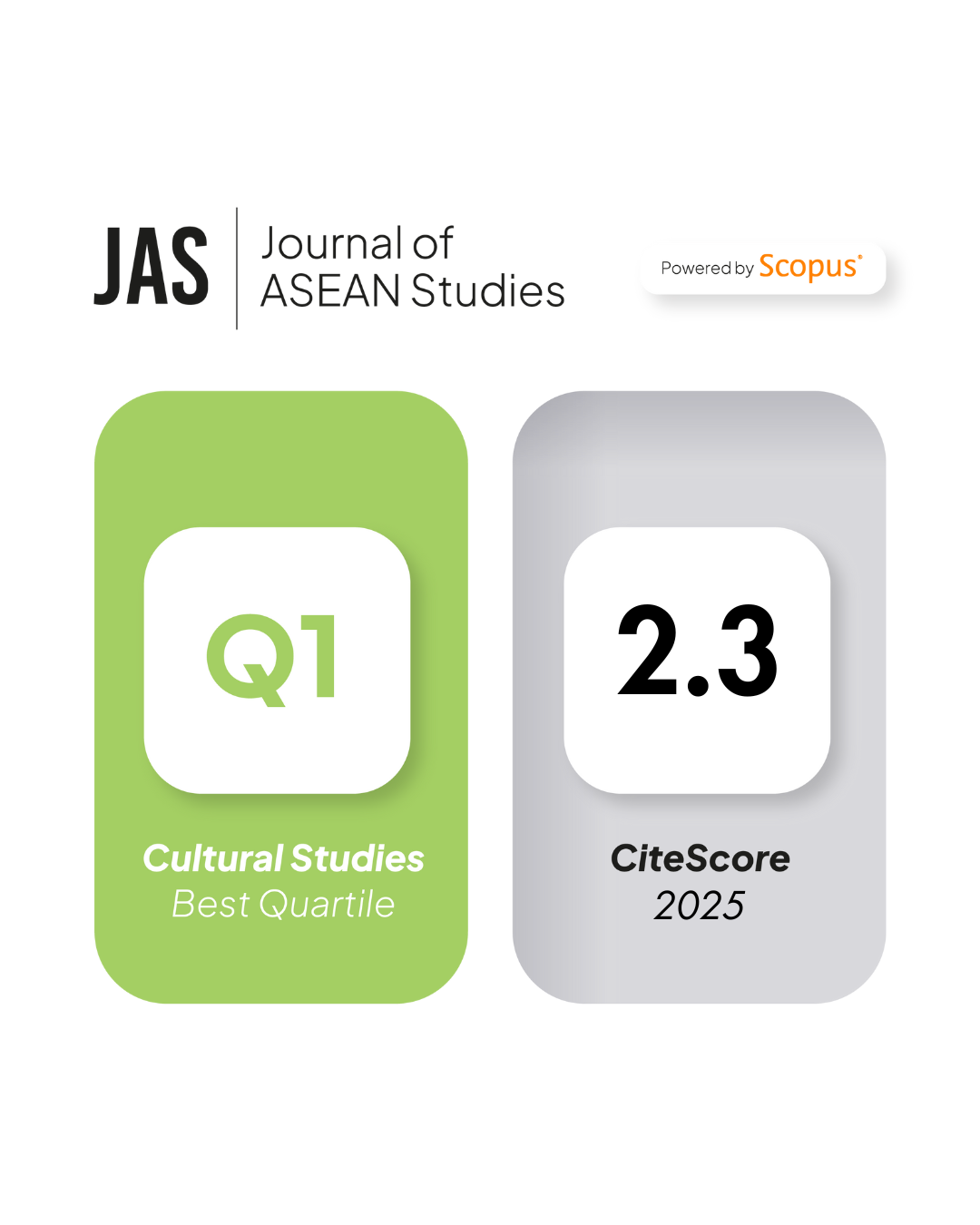Assessing the Expectations and Limitations of ASEAN-EU Counter-Terrorism Cooperation
DOI:
https://doi.org/10.21512/jas.v8i1.6171Keywords:
Regional Securitization, Functionalism, Inter-regionalism, Counterterrorism, ASEAN, EUAbstract
This research examines the inter-regional security cooperation between ASEAN and the EU with a specific focus on counterterrorism. The research methods are based on a comparison of regional counterterrorism governance between the two regions and a close reading of Plan of Actions for the enhancement of ASEAN-EU relations documents from 2007 to 2018. The results show that CT cooperation is about facilitating a more comprehensive security governance cooperation where European standards and experience are transferred to Southeast Asia for purposes of regional security and diplomatic relations. In addition, this research also shows that EU-ASEAN CT cooperation has not been geared specifically to combat radicalism, or as part of a Counter Violent Extremism program; rather, the inter-regional cooperation has mainly focused on building a common normative framework in responding to terrorism within the corridor of democracy and preempting the terrorist networks from exploiting connectivity networks. Finally, implementation of security and political cooperation between the EU and ASEAN tend to rely on the existing extra-regional dialogue fora within ASEAN as well as direct engagement between the EU and third parties comprising each of the ASEAN states.
References
Acharya, A. (2003). Democratisation and the Prospects for Participatory Regionalism in Southeast Asia. Third World Quarterly, 24(2), 375–390. doi: 10.1080/0143659032000074646.
Afoaku, O. G. (2012). Global Security Governance in the 21st Century. https://online.oneill.indiana.edu/doc/syllabi/V550%20-%20GG.pdf
Argomaniz, J., Bures, O. and Kaunert, C. (2015). A decade of EU counter-terrorism and intelligence: A critical assessment. Intelligence and National Security, 30(2–3), 191–206. doi: 10.1080/02684527.2014.988445.
Arianti, V., Sobirin, A., Yeo, K., Mahzam, R., Bashar, I., Chalermsripinyorat, R., & Nasir, A. A. (2019). Southeast Asia: Indonesia, Philippines, Malaysia, Myanmar, Thailand, Singapore. Counter Terrorist Trends and Analysis, 12(1), 5-39. https://www.jstor.org/stable/26865751?seq=1#metadata_info_tab_contents
ASEAN (2007) ASEAN Convention on Counter Terrorism. https://asean.org/storage/2012/05/ACCT.pdf
ASEAN (2013) ASEAN-EU Plan of Action 2013-2017. https://asean.org/storage/images/archive/document/BSB%20Plan%20of%20Action%20to%20Strengthen%20the%20ASEAN-EU%20Enhanced%20Partnership%202013-2017.pdf
ASEAN Regional Forum (2017) ASEAN Regional Forum Work Plan for Counter Terrorism and Transnational Crime. http://aseanregionalforum.asean.org/wp-content/uploads/2018/07/ARF-Work-Plan-on-Counter-Terrorism-and-Transnational-Crime-2015-2017.pdf
Borelli, M. (2017). ASEAN Counter-terrorism weaknesses. Counter Terrorist Trends and Analyses, 9(9), 14–20.
Bos, W., van Ginkel, B., & Mehra, T. (2018). Capacity-building challenges: Identifying progress and remaining gaps in dealing with foreign (terrorist) fighters. The International Centre for Counter-Terrorism - The Hague 9. doi: 10.19165/2018.2.02.
Brattberg, E. & Rhinard, M. (2012). The EU as a global counter-terrorism actor in the making. European Security, 21(4), 557–577.
Carroll, P. & Windle, J. (2018). Cyber as an enabler of terrorism financing, now and in the future. Journal of Policing, Intelligence and Counter Terrorism, 13(3), 285–300.
Chalmers, I. (2017). Countering violent extremism in Indonesia: Bringing back the Jihadists. Asian Studies Review, 41(3), 331–351.
Cross, M. K. D. (2017). Counter-terrorism in the EU’s external relations. Journal of European Integration, 39(5) 609–624.
Dosch, J. & Maier-Knapp, N. (2017). EU-ASEAN relations: Taking stock of a comprehensive inter-regional relationship between natural partners. ASEAN at 50: A Look at Its External Relations. https://www.kas.de/c/document_library/get_file?uuid=a788f795-ff38-0522-1915-9ad120701c4a&groupId=288143
Ehrhart, H.-G., Hegemann, H., & Kahl, M. (2014). Putting security governance to the test: conceptual, empirical, and normative challenges. European Security, 23(2) 119–125.
Emmers, R., Greener, B., & Thomas, N. (2006). Institutional arrangements to counter human trafficking in the Asia Pacific. Contemporary Southeast Asia A Journal of International and Strategic Affairs, 28(3), 490–511.
Emmers, R. (2009). Comprehensive security and resilience in Southeast Asia: ASEAN’s approach to terrorism 1. The Pacific Review, 22(2), 159–177.
European Union (2003) Joint Declaration on Co-operation to Combat Terrorism. https://asean.org/?static_post=14th-asean-eu-ministerial-meeting-brussels-27-28-january-2003-joint-declaration-on-co-operation-to-combat-terrorism-2
Goldman, O. (2011). The globalization of terror attacks. Terrorism and Political Violence, 23(1), 31–59.
Gunaratna, R. (2017). ASEAN’s greatest counter-terrorism challenge: The shift from “Need to know†to Smart to Share. In Combating Violent Extremism and Terrorism in Asia and Europe from Cooperation to Collaboration, 111-128. Konrad-Adenauer-Stiftung Ltd and International Center for Political Violence and Terrorism Research.
He, K. (2019). Constructing dynamic security governance: institutional peace through multilateralism in the Asia Pacific. Journal of Contemporary East Asia Studies, 8(2), 1–16. doi: 10.1080/24761028.2019.1675240.
Hwee, Y. L. (2017). ASEAN’s Cooperation with the European Union – ASEM and Beyond. ASEAN at 50: A Look at Its External Relations. https://www.kas.de/c/document_library/get_file?uuid=a3535cbe-65c3-785d-a3a2-28c852615616&groupId=288143
Kaunert, C. (2009). The external dimension of EU counter-terrorism relations: Competences, interests, and institutions. Terrorism and Political Violence, 22(1), 41–61.
Kim, S.-H. (1999). Comprehensive security effects of the East Asian economic crisis. The Journal of East Asian Affairs, 13(2), 412–433.
Kirchner, E. J. and Dominguez, R. (2014). Security governance in a comparative regional perspective. European Security, 23(2), 163–178.
Klein, G. C. (2006). The social theory of globalization and terrorism. Journal of Police Crisis Negotiations, 6(2), 17–49.
Koh, T., Manalo, R. G. and Woon, W. (eds) (2009) The Making of the ASEAN Charter. Singapore: World Scientific Publishing.
Mackenzie, A., Bures, O., Kaunert, C., & Leonard, S. (2013). The European Union counter-terrorism coordinator and the external dimension of the European Union counter-terrorism policy.
Perspectives on European Politics and Society, 14(3), 325–338.
Maier-Knapp, N. (2015). The non-traditional security concept and the EU-ASEAN relationship against the backdrop of China’s rise. The Pacific Review, 29(3), 411-430.
Martel, S. (2016). From ambiguity to contestation: Discourse(s) of non-traditional security in the ASEAN community. The Pacific Review, 30(4), 549-565.
Mattheis, F. and Wunderlich, U. (2017). Regional actorness and interregional relations: ASEAN, the EU and Mercosur. Journal of European Integration, 9(6), 723–738.
Monar, J. (2014). EU internal security governance: the case of counter-terrorism. European Security, 23(2), 195–209.
Ragazzi, F. & Walmsley, J. (2018). The return of foreign fighters to EU soil. doi: 10.2861/205. https://www.europarl.europa.eu/RegData/etudes/STUD/2018/621811/EPRS_STU(2018)621811_EN.pdf
Rüland, J., 2014. Interregionalism and International relations: Reanimating an obsolescent research agenda? In F. Baert, T. Scaramagli & F. Söderbaum (Ed.), Intersecting Interregionalism: Regions, Global Governance and the EU (pp. 15-36). London: Springer.
Santini, R. H., Lucarelli, S. & Pinfari, M., (2014). Interregionalism: A security studies perspective. In F. Baert, T. Scaramagli & F. Söderbaum (Ed.), Intersecting Interregionalism: Regions, Global Governance and the EU (pp. 71-90). London: Springer.
Singh, D. (2009). Responses to terrorism in Southeast Asia. Journal of Policing, Intelligence and Counter Terrorism, 4(1), 15–28.
Soriano, J. P. (2019). High expectations. Interregional agendas on global security challenges: East Asia, Europe and Latin America. Revista Brasileira de Politica Internacional, 62(1).
Stritzel, H. (2007). Towards a theory of securitization: Copenhagen and beyond. European Journal of International Relations, 13(3), 357–383.
Sukma, R. (2012). The ASEAN political and security community (APSC): Opportunities and constraints for the R2P in Southeast Asia. The Pacific Review, 25(1), 135–152.
Tan, S. S. and Nasu, H. (2016). ASEAN and the development of counter-terrorism law and policy in Southeast Asia. UNSW Law Journal, 39(3), 299–300.
Thayer, C. (2007). The five power defence arrangements: The quiet achiever. Security Challenges, 27(1), 79–96.
Wibisono, A. A. (2017). ASEAN-China non-traditional security cooperation and the inescapability of the politics of security. Jurnal Global & Strategis, 11(1), 39–54.
Zimmerman, E. (2014). Security cooperation in the Indo-Pacific: Non-traditional security as a catalyst. Journal of the Indian Ocean Region, 10(2), 150–165.






















